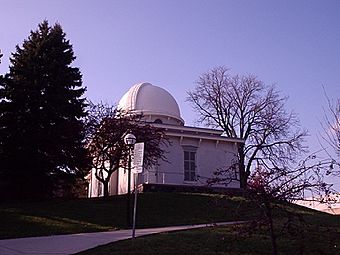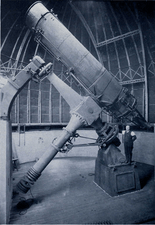Detroit Observatory facts for kids
|
Detroit Observatory
|
|

Detroit Observatory
|
|
| Location | Observatory and Ann Sts., Ann Arbor, Michigan |
|---|---|
| Area | less than one acre |
| Built | 1853 |
| Built by | George Bird |
| Architect | Richard Harrison Bull |
| Architectural style | Greek Revival, Italianate |
| NRHP reference No. | 73000960 |
Quick facts for kids Significant dates |
|
| Added to NRHP | September 20, 1973 |
The Detroit Observatory is a historic building in Ann Arbor, Michigan. It was built in 1854. This observatory was the very first place for scientific research at the University of Michigan. It is also one of the oldest observatories of its kind in the entire country. The observatory was recognized as a Michigan State Historic Site in 1958. Later, in 1973, it was added to the National Register of Historic Places.
Contents
Building a Place to Study Stars
How the Observatory Was Funded
In 1852, Henry Philip Tappan became the president of the University of Michigan. He asked people in Michigan to help fund new research labs. A businessman from Detroit, Henry N. Walker, quickly offered to help.
President Tappan suggested raising money for an observatory. Walker agreed to lead the fundraising effort. Soon, people in Detroit raised over $7,000. Over the next few years, this amount grew to $18,760. Walker himself gave $4,000. Other important people like Lewis Cass and Senator Zachariah Chandler also contributed. The University of Michigan's Board of Regents added more money. In total, about $22,000 was collected for the building and its special instruments.
Designing and Building the Observatory
In 1853, land was bought in Ann Arbor for the observatory. George Bird from New York was hired to manage the building's construction. President Tappan asked Richard Harrison Bull to design the building. Bull was a civil engineering professor and an amateur astronomer.
The building was finished in 1854. It was named the Detroit Observatory to thank the people of Detroit who helped pay for it. The main part of the building had a large dome. Inside the dome was a 12⅝-inch (32 cm) refracting telescope made by Henry Fitz, Jr. When it was installed in 1857, this telescope was the third largest of its kind in the world!
The observatory also had two wings. The east wing held a 6-inch (15 cm) meridian circle telescope. The west wing was used as a library and an office for the director.
Changes and Updates to the Building
Over the years, the Detroit Observatory changed. In 1890, the way the dome rotated was improved. A house for the observatory director was added in 1868. This house was made bigger in 1905-06.
In 1908, a new, larger section was added. This part included more offices and a second dome. This new dome was meant for a bigger 37+1⁄2-inch (950 mm) reflecting telescope. However, the director's house was torn down in 1954. The 1908 addition was also removed in 1976.
Saving the Observatory
The astronomy department moved out of the building in 1963. After that, the Detroit Observatory was used as a library and then as a storage room. It started to fall apart. In the 1970s, there was a plan to tear it down completely.
Luckily, the building was added to the National Register of Historic Places in 1973. This helped save it! The observatory was restored and fixed up in 1997-98. Since 2005, the Detroit Observatory has been part of the Bentley Historical Library.
Other observatories at the University of Michigan gradually took over the work of the Detroit Observatory. These include the Angell Hall Observatory (1927), the Lamont-Hussey Observatory in South Africa (1928), and the McMath–Hulbert Observatory in Lake Angelus, Michigan (1930).
Amazing Discoveries at the Detroit Observatory
Leading the Way in Astronomy Education
The scientists at the Detroit Observatory made big contributions to astronomy in the late 1800s. The first director, Franz Brünnow, joined the University of Michigan in 1856. He was a famous astronomer from Berlin, Germany.
Brünnow made the astronomy courses at the University of Michigan much better. He used the "German Method." This way of teaching focused on strong math skills, careful observation, and reducing errors. He created the most detailed astronomy course offered in the United States at that time. Students spent two years studying advanced math and learning to use the observatory's telescopes.
Brünnow also studied asteroids, comets, and how far away stars are. He started a journal called Astronomical Notices. This was the first academic journal at the University of Michigan. It published research from astronomers in America and Europe.
Thanks to Brünnow's program, about a quarter of the top astronomers and meteorologists in the U.S. by the end of the century had studied at the Detroit Observatory. It was known as "the place to study astronomy."
Discovering Asteroids with James Craig Watson
James Craig Watson, one of Brünnow's students, became the second director in 1863. Watson continued the strong education and research program. He was very skilled at observing and using math.
Watson was famous for finding asteroids. From 1863 to 1877, he discovered 22 asteroids! This was almost a quarter of all asteroids found during that time. In 1868, he found six asteroids in one year. This was a huge achievement, and he won the Lalande Prize for it.
Watson also studied comets. He worked on mapping different areas of the sky. In 1878, he got money to build a small observatory for students. This allowed students to use telescopes more often. This student observatory was later moved to the roof of Angell Hall.
Watson left the University of Michigan in 1879. He wanted the university to fund a larger telescope, but they did not. He moved to Wisconsin to oversee another observatory. Sadly, he passed away soon after.
Important Directors and Students
Franz Brünnow was the first director from 1854 to 1863. Some of his notable students included Asaph Hall, Cleveland Abbe, and James Craig Watson.
James Craig Watson took over as director from 1863 to 1879. His students included Otto Julius Klotz and John Martin Schaeberle.
Here is a list of the directors of the Detroit Observatory:
| Name | Dates of service | Notes |
|---|---|---|
| Franz Brünnow | 1854–1863 | |
| James Craig Watson | 1863–1879 | |
| Mark W. Harrington | 1879–1891 | |
| Asaph Hall, Jr. | 1892–1905 | |
| William J. Hussey | 1905-1926 1891-1892 (acting) |
|
| Ralph H. Curtiss | 1927–1929 1926 (acting) |
|
| Heber D. Curtis | 1930–1941 | |
| W. Carl Rufus | 1929–1930 (acting) 1942–1945 (acting) |
|
| A. D. Maxwell | 1945–1946 (acting) | |
| Leo Goldberg | 1946–1960 | |
| Freeman D. Miller | 1960–1961 (acting) | |
| Orren C. Mohler | 1962–1970 | |
| W. Albert Hiltner | 1970–1982 |
What the Building Looks Like
The Detroit Observatory is on the campus of the University of Michigan. It is a two-story building with a hip roof. It measures 33 feet (10 m) on each side. It has two smaller, one-story wings, each 19 feet (5.8 m) by 29 feet (8.8 m). This design was common for observatories built in the 1800s.
The building is made of solid brick. It is covered with stucco that is painted to look like large granite blocks. On top, there is a big, round dome made of wood and canvas. This dome is 21 feet (6.4 m) across and can rotate. A small porch covers the main entrance.
See also
 In Spanish: Observatorio Detroit para niños
In Spanish: Observatorio Detroit para niños




